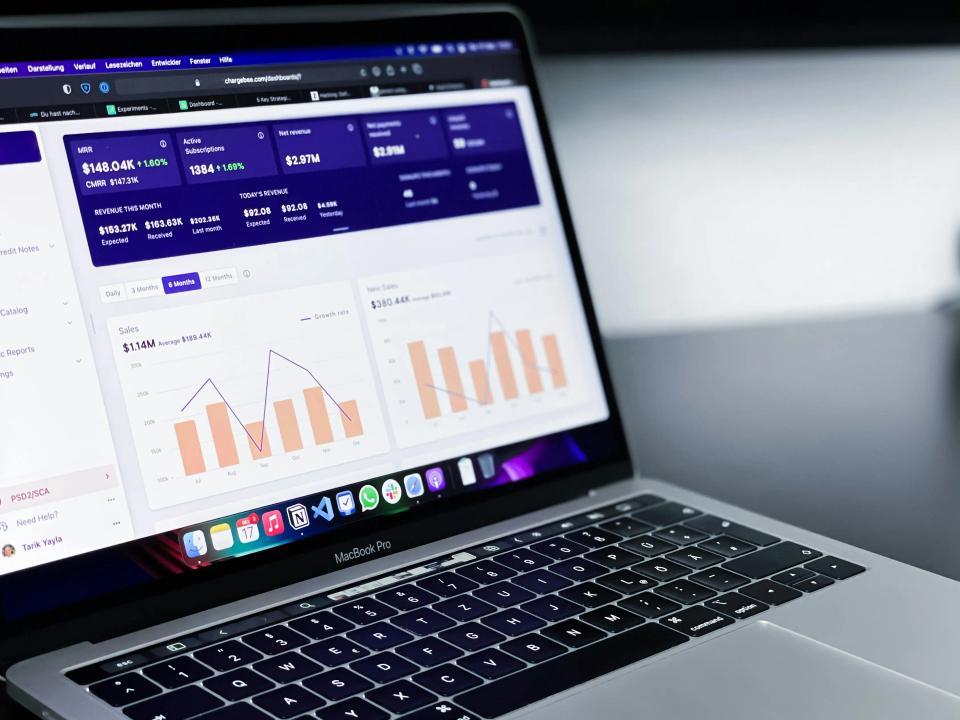Feeling stuck? Like your small business has hit a growth ceiling, and you’re staring at new markets, wondering how to break in? You’re not alone. Many ambitious entrepreneurs reach a point where the usual digital marketing playbook just doesn’t cut it anymore.
Basic digital marketing is a great start, a solid foundation. But expansion? That’s a whole different beast. It demands more sophisticated, more potent, "next-level" approaches to truly capture new territories and customer segments. This isn't just about doing more; it's about doing things smarter, sharper, and with more impact.
Get ready. This post will pull back the curtain on innovative and practical digital marketing strategies designed to shatter those growth barriers. We're talking about the kind of tactics that can propel your small business into significant, sustainable expansion. At CaptivateClick, we’ve seen firsthand how strategic digital marketing transforms businesses, helping them scale and conquer new horizons, and we’re here to share that insight.
Why "Next-Level" Matters for Small Business Expansion
Ever feel like you're running hard but staying in the same place? In today's hyper-competitive digital arena, "good enough" marketing is often just… not enough. Your competitors are getting savvier, and customer expectations are constantly rising. Relying on outdated or overly simplistic tactics means you're likely leaving a mountain of opportunity on the table.
Think about the opportunity cost. Every day you're not innovating, not pushing the boundaries of your marketing, is a day your more agile competitors might be. The digital landscape waits for no one, and stagnation is the silent killer of growth. Failing to adopt advanced strategies isn't just about missing out on potential gains; it's about risking relevance.
But here’s the exciting part: strategic, advanced digital marketing tactics are the keys to unlocking entirely new customer segments and previously unreachable markets. These aren't just minor tweaks; they're powerful levers that can create exponential growth. It’s about moving from casting a wide, hopeful net to spearing your ideal customers with laser precision. These next-level strategies are your roadmap to not just growth, but true market expansion.
Strategy 1: Hyper-Personalized Content Marketing & SEO Synergy
Stop shouting into the void with generic blog posts. True expansion begins when you move beyond basic content and dive deep into understanding your customer personas – their pains, desires, and the journey they take before they even think about buying. This isn't just demographics; it's about empathy at scale, crafting messages that resonate because they feel personal.
This means embracing an advanced keyword strategy. Forget just stuffing keywords; focus on long-tail phrases, the actual questions your ideal customers are typing into search engines. Understand user intent and leverage semantic search to dominate your niche. As highlighted in HubSpot’s Marketing Hub insights, tools like AI Content Assistants can now help generate SEO-optimized drafts that align with these sophisticated approaches, ensuring your content truly connects. For a solid foundation, explore these essential SEO strategies to elevate your website ranking.
Build your authority with content pillars and topic clusters. Imagine creating a comprehensive library around your core expertise, attracting and retaining specific audiences hungry for your knowledge. According to Moz's guide on topic clusters, this structure significantly boosts SEO performance. Diversify with interactive content like quizzes, calculators, webinars, and advanced video – formats that don’t just inform, but actively engage and capture those precious leads.
Practical Tip: Use tools like AnswerThePublic or SEMrush to uncover deep customer questions for your content.
Strategy 2: Mastering Niche Social Media & Community Building
Are your social media efforts just a one-way broadcast? It's time to shift gears. Next-level social media for expansion is all about fostering genuine engagement, building vibrant communities, and turning customers into passionate brand advocates. This isn't about vanity metrics; it's about creating real connections that drive loyalty and word-of-mouth.
Dive deep into platform-specific strategies. Instead of spreading yourself thin, identify and dominate less crowded, highly relevant social platforms for your niche. Think niche forums, specific LinkedIn groups, or even TikTok if your audience is there. As Buffer’s community-building framework illustrates, creating spaces for respectful interaction and shared interests can build incredibly strong bonds.
Unleash the power of your customers with User-Generated Content (UGC) campaigns. Let them be your most authentic marketers. Micro-influencer collaborations can also be goldmines; these individuals often have highly engaged, niche audiences. Nomadz Digital highlights that micro-influencers boast higher engagement rates, making them powerful allies in reaching your target expansion audience with authenticity.
Practical Tip: Run a contest encouraging customers to share how they use your product/service with a unique hashtag.
Strategy 3: Data-Driven Paid Advertising & Retargeting Funnels
Stop throwing money at basic boosted posts and hoping for the best. True expansion demands smarter ad spend, moving towards sophisticated audience segmentation and powerful lookalike audiences. You need to reach the right people, not just more people. For insights into platform-specific ad strategies, consider exploring how to harness Facebook and Instagram Ads for conversion growth or even innovative Google Ads techniques for specialized firms.
Implement advanced retargeting strategies. Don't let interested prospects slip through your fingers. Create multi-step retargeting funnels based on specific user behaviors – did they abandon a cart, view specific content, or download a resource? As WordStream explains regarding Remarketing Lists for Search Ads (RLSA), you can tailor bids and ads for users who've already shown interest. Chaosmap further details how B2B retargeting funnels can nurture leads through different stages of consideration.
Master the art of A/B testing. Continuously test your ad copy, creative elements, and landing pages to squeeze every last drop of performance from your budget. Sprout Social notes that Facebook’s algorithm prioritizes video content, often generating significantly higher engagement. For B2B expansion, LinkedIn Ads offer unparalleled targeting capabilities to reach decision-makers in new industries or regions.
Practical Tip: Set up custom audiences in Facebook Ads Manager based on website visitors who viewed specific product pages but didn't purchase.
Strategy 4: Strategic Local SEO for Geographic Expansion
Thinking of planting your flag in new physical territories or serving wider local areas? Your Google My Business profile is just the starting line. Next-level local SEO involves advanced tactics designed to make you the dominant force in each target location. This is about being the go-to business when locals search. To get started, understand how to boost local SEO for nearby businesses and then explore more advanced local SEO techniques beyond traditional optimization.
Create dedicated, optimized location-specific landing pages for each target area. This isn't just duplicating content; it's tailoring your message, keywords, and even imagery to resonate with the local community. Dive into local SEO content marketing by creating locally relevant content that ranks. Build local citations and backlinks consistently across relevant directories to establish your authority in these new geographic markets. Semrush Local can help identify inconsistent citations, ensuring your NAP (Name, Address, Phone) information is uniform and trustworthy.
Encourage a steady stream of geo-tagged reviews from customers in your new service areas. This builds powerful social proof; Moz community discussions highlight that 68% of consumers trust local businesses with 4+ stars. Implementing local schema markup helps search engines understand your service areas and business hours, improving your visibility. For businesses with multiple locations, specific advanced local SEO strategies for multi-location brands are crucial.
Practical Tip: For each new service area, create a dedicated page on your website with localized content, testimonials, and schema markup.
Strategy 5: Next-Level Lead Generation & Nurturing Automation
Are your lead generation efforts feeling a bit… manual and scattergun? To truly scale and expand, you need sophisticated email outreach and intelligent automation. This means personalized, segmented email campaigns that go far beyond generic newsletters, delivering the right message to the right person at the right time. Explore innovative email outreach techniques for B2B lead generation to see what's possible.
Implement marketing automation workflows. Set up automated sequences that nurture leads based on their interactions with your brand – what they clicked, what they downloaded, what pages they visited. Mailchimp's platform allows for automation workflows like abandoned cart reminders, while ActiveCampaign enables dynamic content insertion in emails for deep personalization. For specific industries, even cold email outreach tactics for law firms can be highly effective when done strategically.
Don't forget LinkedIn outreach, especially for B2B expansion, using tools and techniques for targeted professional networking and lead acquisition at scale. Crucially, focus on Conversion Rate Optimization (CRO) for all your landing pages and lead capture forms. Even small tweaks can lead to big gains; Mailchimp suggests that A/B testing landing page elements can increase conversions significantly. Ensure your email marketing tactics actually drive lead generation.
Practical Tip: Implement a lead scoring system to prioritize follow-up with the most engaged prospects.
Strategy 6: Building a Scalable Brand Identity for New Markets
Is your brand more than just a pretty logo? As you eye new markets, you need to ensure your entire brand strategy – from visual identity to core messaging – is robust, adaptable, and ready to resonate with diverse audiences. This is about building a brand that can travel, that feels authentic and compelling wherever it goes. A great starting point is creating a cohesive brand identity with strategic website design.
Develop comprehensive brand guidelines. These are your brand’s bible, ensuring consistency in how your logo is used, your color palettes (specify CMYK/RGB codes), typography, and tone of voice, especially as your team grows or you work with new partners. Bynder offers a solid framework for defining brand guidelines. This consistency is key to transforming your brand identity with impactful logo design and visual storytelling.
Be prepared to adapt your messaging if necessary. Understand cultural nuances if you're expanding internationally or targeting diverse demographic groups within your current market. Your core values should remain, but the way you communicate them might need to flex. Craft a brand narrative that connects on an emotional level, appealing to broader audiences while staying true to who you are. Interbrand’s Brand Strength metrics emphasize how brands must evolve while retaining core values. Often, this involves a step-by-step guide to branding through a website redesign to ensure your digital presence reflects your evolved identity.
Practical Tip: Conduct a brand audit. Does your current visual identity and messaging feel modern and adaptable for future growth?
Strategy 7: Leveraging Analytics & Performance Optimization for Continuous Growth
Are you truly listening to what your data is telling you? Expansion efforts demand a deep dive into analytics, moving beyond vanity metrics to understand true ROI, customer behavior, and campaign effectiveness. This is about making informed decisions, not guessing.
Define clear Key Performance Indicators (KPIs) specifically for your expansion initiatives. What does success look like in these new markets? Track metrics like traffic from new regions, conversion rates from localized campaigns, and customer acquisition cost per segment. Semrush provides guidance on setting up Google Analytics dashboards to monitor these vital signs. Ensure your website performance is top-notch; it must be fast, secure, and mobile-friendly to handle increased traffic and provide an excellent user experience. This often involves optimizing website performance with advanced technical SEO tactics.
Embrace iterative improvement. Use the data you collect to continuously refine all your digital marketing strategies. Digital marketing isn't a "set it and forget it" game, especially when expanding. Bluehost highlights that SEO and email marketing can deliver significantly higher returns than traditional methods, but only with ongoing optimization. Don't overlook the foundations; our ultimate guide to technical SEO for web performance optimization can help ensure your site is always ready for growth, including leveraging technical optimization for mobile website performance.
Practical Tip: Set up custom dashboards in Google Analytics to track metrics specifically related to your expansion goals (e.g., traffic from new regions, conversions from specific campaigns).
Overarching Considerations for Next-Level Success
Remember, these powerful strategies don't operate in a vacuum. Integration is absolutely key. Your hyper-personalized content should fuel your social media engagement, which in turn can feed your retargeting funnels, all while your local SEO efforts make you discoverable in new territories. Think of it as an interconnected ecosystem working towards a common goal: expansion.
At the heart of it all lies a strong web presence. Your website is your digital flagship, the foundation upon which all these next-level strategies are built. It needs to be well-designed, technically sound, user-friendly, and optimized for conversions. Having the essential tools and tech for advanced digital marketing strategies is crucial, but they are most effective when supporting a robust online hub.
Be patient and persistent. Next-level results don't happen overnight. They require consistent effort, ongoing learning, and the willingness to adapt. And sometimes, you need to know when to call in the cavalry. While DIY can get you far, partnering with an agency like CaptivateClick can provide specialized expertise, accelerate your progress, and help you navigate the complexities of true market expansion.
Conclusion
Breaking into new markets and achieving significant small business expansion isn't a distant dream—it's a tangible reality when you deploy the right, innovative digital marketing strategies. You've seen how moving beyond the basics can unlock incredible potential. From hyper-personalization to data-driven advertising and robust brand building, these next-level tactics are your arsenal for growth.
Don't feel overwhelmed. Start by picking one or two strategies that resonate most with your current challenges and expansion goals. Begin implementing, testing, and learning. Every step forward, no matter how small it seems, is progress.
Remember, investing in these advanced digital marketing strategies is a direct investment in your business's future, its resilience, and its ability to thrive. The path to next-level digital marketing and sustainable small business expansion is clear. The only question is: are you ready to take it?













